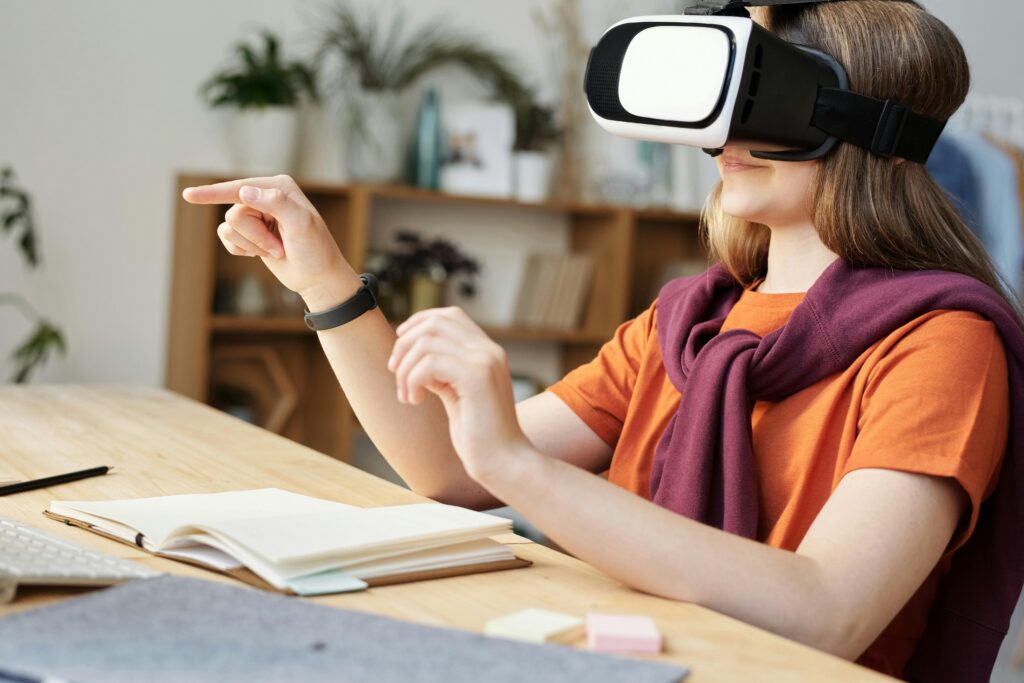
The possible applications for this immersive technology have expanded along with the virtual reality (VR) landscape. Virtual reality has evolved beyond a mere amusement source to become a potent tool for fostering improved teamwork, productivity, and creativity in a variety of settings.
Virtual reality (VR) has shown to be a fantastic tool for changing the way we teach and learn in the educational field. It lets students explore and engage with realistic settings in a way that has never been possible before. With the correct tools, teachers can provide students with the soft skills and practical knowledge they need to succeed in the workforce.
This is your exclusive behind-the-scenes look at how virtual reality is transforming higher education.
Why Does Higher Education Need to Use VR Technology?
According to a 2020 PWC study, virtual reality has enormous educational benefits. VR students finished courses four times faster, were four times more attentive, and had a 3.75 times stronger emotional connection to the material than students in traditional classroom settings. The research conducted by prominent VRaaS (Virtual Reality as a Service) provider Virtualware expands upon these findings.
After receiving VR instruction, they found that 90% of students felt more comfortable applying their new abilities. Furthermore, they attained up to 75% knowledge retention rates, as opposed to only 5–10% for traditional learning strategies. In higher education, virtual reality can:
Give Students Access to Essential Soft Skills
One type of “experiential” learning is virtual reality. This implies that instruction is imparted to students via realistic, hands-on simulations of real-world settings. With up to 90% information retention rates, this type of instruction is very helpful for developing soft skills.
Students can participate in role-playing activities in authentic settings with virtual reality. VR systems that use AI and speech analysis can assess students’ verbal communication abilities thoroughly and give them rapid feedback. Additionally, by enabling kids to communicate with “virtual characters,” they can provide them the self-assurance they need to work together and communicate more successfully with others in the real world.
Break Down Educational Barriers
Investing in distance learning initiatives and virtual reality (VR) offers an opportunity to provide immersive experiences to all students, regardless of location, as higher education campuses grow more global. Virtual reality (VR) can be used as a service by educational institutions to build whole virtual campus environments for training, networking, lectures, and events that take place year-round.
This guarantees that all students, even those who are unable to attend classes individually, can experience the entire “classroom” experience. It can also aid in attracting new students to schools and universities by providing them with the opportunity to virtually experience digital twins of campus areas. According to one study, virtual reality experiences for universities like Yale, Harvard, and Princeton increased the number of people who visited the campuses in person by 27%.
Enhance the Learning Experience for Students
VR has the ability to make learning more engaging than any other technology. Users can experiment with situations that they would not be able to access on a conventional college campus. In order to improve students’ learning in health, engineering, and architecture, the University of El Salvador (UES), the only public university in the nation, erected seven virtual reality laboratories in 2022 and 2023.
With VIROO, the VR technology that underpins the new labs, the UES Faculties of Medicine, Dentistry, Chemistry, and Pharmacy can design novel learning models and provide more dynamic and engaging classes.
Students can use this platform to make their own virtual reality content and to interact and work together in real time from seven different rooms in Santa Ana, San Miguel, and San Salvador, both in person and virtually. They don’t have to travel to explore a variety of locations. Even the sessions can be modified to accommodate many students with varying needs, skill levels, and learning styles.
Medical students can perform procedures on virtual bodies, history students can visit historical ruins, and engineering students can utilize VR to create skyscrapers. These immersive learning opportunities not only increase student engagement but also save higher education institutions money on field excursions and other supplies needed to provide experiential learning.
Improve the quality of group education
Virtual reality (VR) has the potential to greatly enhance peer, teacher, and student cooperation in the classroom. Students can communicate and form relationships with individuals, no matter where they are in the world, by using avatars. Additionally, virtual reality platforms enable educators to design settings in which geographically dispersed students collaborate in real time on assignments.
In 2021, for example, the Colombian university Universidad EAN included this platform into its curricula. Since then, the students have continued to innovate the instructional materials by independently producing a variety of VR content, especially for the business and technology disciplines.
Get Students Ready for the Workplace
Perhaps the biggest benefit of VR in higher education is its ability to prepare students for vocational experiences. With VR, higher education facilities can create simulations of typical workplace environments, where learners can prepare for their entry into the working world.
“34 vocational training institutions throughout Spain are getting the VIROO platform installed as part of the Basque Government’s plan to incorporate immersive technologies into education; 25 of those centers have VR rooms specifically designed for this purpose. “This initiative sets a new standard in VR education by enabling teachers and students to create, manage, and deploy VR resources in an easy-to-use, cost-effective, and secure manner,” continues Unai Extremo, CEO of Virtualware”
VR Examples in Higher Education
Innovative campuses and higher education establishments are already reaping the rewards of virtual reality. During the 2023 International Vocational Training Congress, Spain’s Minister of Education disclosed that more than fifteen recently established virtual reality training facilities spread around the area were already contributing to better teaching-learning procedures and student empowerment.
Globally, case studies are beginning to appear. For instance, a new Immersive Technologies room under the VIROO platform has been developed as part of the UniMetaTech Innovation Center (March 2024). The objective is to enhance UniMetaTech’s educational innovation by bolstering UNIMETA’s competitiveness in immersive technologies, fostering employment and entrepreneurship, and progressively incorporating this technology into training procedures.
These areas not only provide students with the ability to investigate virtual worlds for experiential learning, but they also enable teachers.
For example, the teachers in the academy can simply manage, administer, and adjust learning resources and activities in the labs to different subjects and learning levels by using the flexible VIROO platform. This makes training more flexible and adaptable, enabling it to change over time to meet the needs of several students pursuing various career paths.
Using Virtual Reality in Postsecondary Education
Universities and colleges work hard to provide their students with the newest tools and resources possible. Regretfully, it’s frequently challenging to guarantee that every kid has access to the same resources due to insufficient funding. Students frequently have to share tools with other students, which reduces the amount of time they can spend having hands-on experiences.
Systems such as VIROO VRaaS from Virtualware facilitate improved information transfer and retention, raise student motivation, and even increase enrollment. Additionally, they guarantee that educational institutions can adequately equip students for real-world situations by exposing them to authentic locations and circumstances that boost their self-assurance and skill sets.







